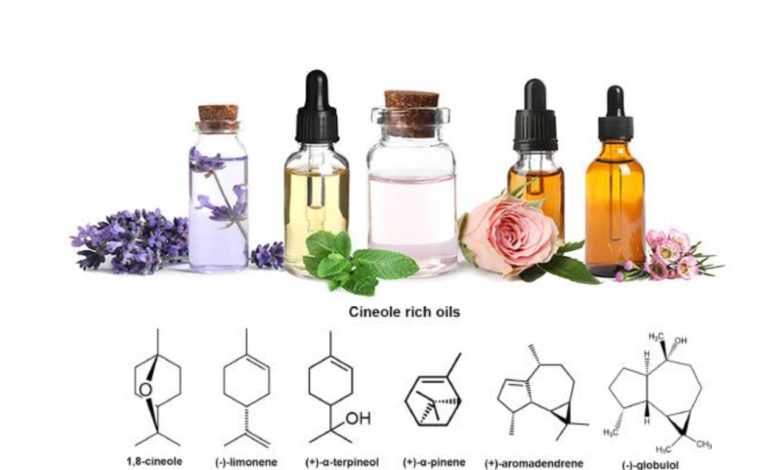Chemical Composition Of 20 Common Essential Oils

Essential oils are natural aromatic compounds found in various parts of plants such as the flowers, leaves, stems, roots, bark, and seeds. They are typically extracted through methods such as distillation, cold pressing, or solvent extraction. These oils capture the characteristic scent and flavor of the plant from which they are derived and contain the plant’s beneficial properties.
Historically, essential oils have been used for a wide range of purposes across different cultures and civilizations:
- Aromatherapy: Essential oils have been used for their aromatic properties to promote relaxation, uplift mood, and enhance overall well-being. They are commonly diffused into the air or added to baths for aromatherapy purposes.
- Medicinal Uses: Many essential oils have antimicrobial, anti-inflammatory, and analgesic properties, making them valuable for treating various health conditions. They have been used in traditional medicine systems such as Ayurveda, Traditional Chinese Medicine, and herbal medicine for centuries.
- Perfumery: Essential oils are widely used in perfumery for their aromatic qualities. They provide natural fragrances that are often preferred over synthetic fragrances.
- Cosmetics and Personal Care: Essential oils are common ingredients in skincare products, hair care products, soaps, and other personal care items due to their beneficial effects on the skin and hair.
- Cleaning and Disinfection: Many essential oils have strong antimicrobial properties, making them effective natural alternatives to chemical-based cleaning products. They are often used in household cleaners and disinfectants.
- Religious and Spiritual Practices: Essential oils have been used in religious rituals, ceremonies, and spiritual practices for their symbolic significance and ability to create a sacred atmosphere.
- Food Flavoring: Some essential oils are used as flavoring agents in food and beverages due to their intense flavors and aromas. They are particularly popular in culinary traditions such as Mediterranean and Asian cuisines.
Throughout history, essential oils have played a significant role in various aspects of human life, from health and wellness to culture and spirituality. Their use continues to evolve, with ongoing research uncovering new potential applications and benefits. However, it’s important to note that essential oils are highly concentrated substances and should be used with caution, following proper dilution and safety guidelines.
Chemical Composition Of Essential Oils
Table listing the chemical composition of 20 common essential oils:
| Essential Oil | Chemical Composition |
| Lavender | Linalool, linalyl acetate, 1,8-cineole, camphor, terpinen-4-ol, lavandulyl acetate |
| Peppermint | Menthol, menthone, menthyl acetate, 1,8-cineole, limonene, pulegone |
| Tea Tree | Terpinen-4-ol, γ-terpinene, α-terpinene, 1,8-cineole, α-pinene, β-pinene |
| Eucalyptus | 1,8-cineole, α-pinene, limonene, α-terpineol, piperitone, globulol |
| Lemon | Limonene, β-pinene, γ-terpinene, citral, α-pinene, sabinene |
| Rosemary | 1,8-cineole, α-pinene, camphor, β-pinene, camphene, limonene |
| Frankincense | α-Pinene, α-thujene, α-phellandrene, limonene, β-pinene, myrcene |
| Chamomile | Chamazulene, α-bisabolol, bisabolol oxide A, bisabolol oxide B, farnesene |
| Sandalwood | α-Santalol, β-santalol, epi-β-santalol, α-trans-bergamotol, santalenes |
| Cedarwood | α-Cedrene, β-cedrene, thujopsene, cedrol, widdrol, α-cedrene |
| Ylang Ylang | Benzyl acetate, linalool, geranyl acetate, p-cresyl methyl ether, β-caryophyllene |
| Peppermint | Menthol, menthone, menthyl acetate, 1,8-cineole, limonene, pulegone |
| Lemongrass | Citral, geraniol, nerol, myrcene, citronellal, limonene |
| Patchouli | Patchoulol, α-bulnesene, α-guaiene, β-caryophyllene, α-patchoulene, α-bulnesene |
| Bergamot | Limonene, linalyl acetate, linalool, γ-terpinene, β-pinene, α-pinene |
| Geranium | Citronellol, geraniol, linalool, isomenthone, citronellyl formate, 10-epi-γ-eudesmol |
| Clary Sage | Linalyl acetate, linalool, sclareol, α-terpineol, germacrene D, caryophyllene oxide |
| Thyme | Thymol, p-cymene, γ-terpinene, carvacrol, myrcene, linalool |
| Cedarwood | α-Cedrene, β-cedrene, thujopsene, cedrol, widdrol, α-cedrene |
| Jasmine | Benzyl acetate, linalool, benzyl alcohol, indole, cis-jasmone, methyl anthranilate |
Factors that affect variation in the chemical composition of essential oils
The chemical composition of essential oils can vary significantly due to several factors, ranging from environmental conditions to genetic differences among plant species. Understanding these factors is crucial for ensuring consistency and quality in essential oil production, as well as for maximizing their therapeutic and aromatic properties. In this essay, we will explore the primary factors that influence the variation in the chemical composition of essential oils.
- Plant Species and Varieties: Different plant species produce essential oils with distinct chemical profiles. Even within the same species, different varieties or cultivars may yield oils with varying compositions. For example, there are multiple varieties of lavender (Lavandula angustifolia), each containing different concentrations of key compounds such as linalool and linalyl acetate.
- Plant Part Used: Essential oils can be extracted from various parts of plants, including flowers, leaves, stems, bark, roots, and seeds. The chemical composition of an essential oil can differ depending on the plant part used for extraction. For instance, the oil extracted from citrus peels tends to contain high levels of limonene, while oils derived from flowers may be rich in floral compounds like geraniol and linalool.
- Geographic Location: Environmental factors such as climate, soil composition, altitude, and sunlight exposure can greatly influence the chemical composition of essential oils. Plants grown in different regions may produce oils with distinct aromatic profiles and therapeutic properties. For example, French lavender (Lavandula angustifolia) cultivated at higher altitudes often yields oils with higher concentrations of linalool and linalyl acetate compared to those grown at lower elevations.
- Climate and Weather Conditions: Weather fluctuations, including temperature, humidity, rainfall, and seasonal changes, can impact plant growth and essential oil production. Extreme weather conditions or fluctuations in temperature and precipitation levels may alter the synthesis and accumulation of volatile compounds within plants, leading to variations in the chemical composition of essential oils.
- Harvesting Practices: The timing and method of harvest can affect the quality and composition of essential oils. Harvesting at the optimal stage of plant development, when essential oil content is highest, is crucial for obtaining oils with desired properties. Additionally, proper harvesting techniques, such as handpicking versus mechanical harvesting, can influence the integrity of plant tissues and the extraction process.
- Extraction Methods: Various extraction techniques, such as steam distillation, cold pressing, solvent extraction, and CO2 extraction, can yield essential oils with different chemical profiles. Factors such as temperature, pressure, duration of extraction, and solvent used (if applicable) can impact the efficiency and selectivity of extraction, thereby influencing the composition of the final oil.
- Storage and Handling: Proper storage conditions, including temperature, light exposure, and air quality, are essential for maintaining the stability and quality of essential oils over time. Improper storage can lead to oxidation, degradation, or evaporation of volatile compounds, resulting in changes to the chemical composition and aroma of the oil.
- Genetic Factors: Genetic variation within plant populations can contribute to differences in essential oil composition. Breeding programs aimed at selecting plants with desired traits, such as higher oil yields or specific chemical profiles, can influence the overall composition of essential oils produced from cultivated varieties.
In conclusion, the chemical composition of essential oils is influenced by a complex interplay of factors, including plant species, environmental conditions, geographic location, climate, harvesting practices, extraction methods, storage conditions, and genetic factors. Understanding and managing these factors are essential for ensuring consistency, quality, and efficacy in essential oil production and utilization across various industries, including aromatherapy, cosmetics, food flavoring, and herbal medicine.





